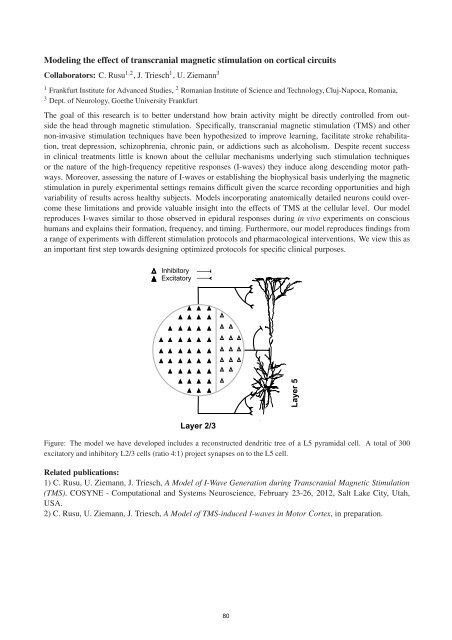FIAS Scientific Report 2011 - Frankfurt Institute for Advanced Studies ...
FIAS Scientific Report 2011 - Frankfurt Institute for Advanced Studies ...
FIAS Scientific Report 2011 - Frankfurt Institute for Advanced Studies ...
Create successful ePaper yourself
Turn your PDF publications into a flip-book with our unique Google optimized e-Paper software.
Modeling the effect of transcranial magnetic stimulation on cortical circuits<br />
Collaborators: C. Rusu 1,2 , J. Triesch 1 , U. Ziemann 3<br />
1 <strong>Frankfurt</strong> <strong>Institute</strong> <strong>for</strong> <strong>Advanced</strong> <strong>Studies</strong>, 2 Romanian <strong>Institute</strong> of Science and Technology, Cluj-Napoca, Romania,<br />
3 Dept. of Neurology, Goethe University <strong>Frankfurt</strong><br />
The goal of this research is to better understand how brain activity might be directly controlled from outside<br />
the head through magnetic stimulation. Specifically, transcranial magnetic stimulation (TMS) and other<br />
non-invasive stimulation techniques have been hypothesized to improve learning, facilitate stroke rehabilitation,<br />
treat depression, schizophrenia, chronic pain, or addictions such as alcoholism. Despite recent success<br />
in clinical treatments little is known about the cellular mechanisms underlying such stimulation techniques<br />
or the nature of the high-frequency repetitive responses (I-waves) they induce along descending motor pathways.<br />
Moreover, assessing the nature of I-waves or establishing the biophysical basis underlying the magnetic<br />
stimulation in purely experimental settings remains difficult given the scarce recording opportunities and high<br />
variability of results across healthy subjects. Models incorporating anatomically detailed neurons could overcome<br />
these limitations and provide valuable insight into the effects of TMS at the cellular level. Our model<br />
reproduces I-waves similar to those observed in epidural responses during in vivo experiments on conscious<br />
humans and explains their <strong>for</strong>mation, frequency, and timing. Furthermore, our model reproduces findings from<br />
a range of experiments with different stimulation protocols and pharmacological interventions. We view this as<br />
an important first step towards designing optimized protocols <strong>for</strong> specific clinical purposes.<br />
Inhibitory<br />
Excitatory<br />
Layer 2/3<br />
Figure: The model we have developed includes a reconstructed dendritic tree of a L5 pyramidal cell. A total of 300<br />
excitatory and inhibitory L2/3 cells (ratio 4:1) project synapses on to the L5 cell.<br />
Related publications:<br />
1) C. Rusu, U. Ziemann, J. Triesch, A Model of I-Wave Generation during Transcranial Magnetic Stimulation<br />
(TMS). COSYNE - Computational and Systems Neuroscience, February 23-26, 2012, Salt Lake City, Utah,<br />
USA.<br />
2) C. Rusu, U. Ziemann, J. Triesch, A Model of TMS-induced I-waves in Motor Cortex, in preparation.<br />
80<br />
Layer 5
















